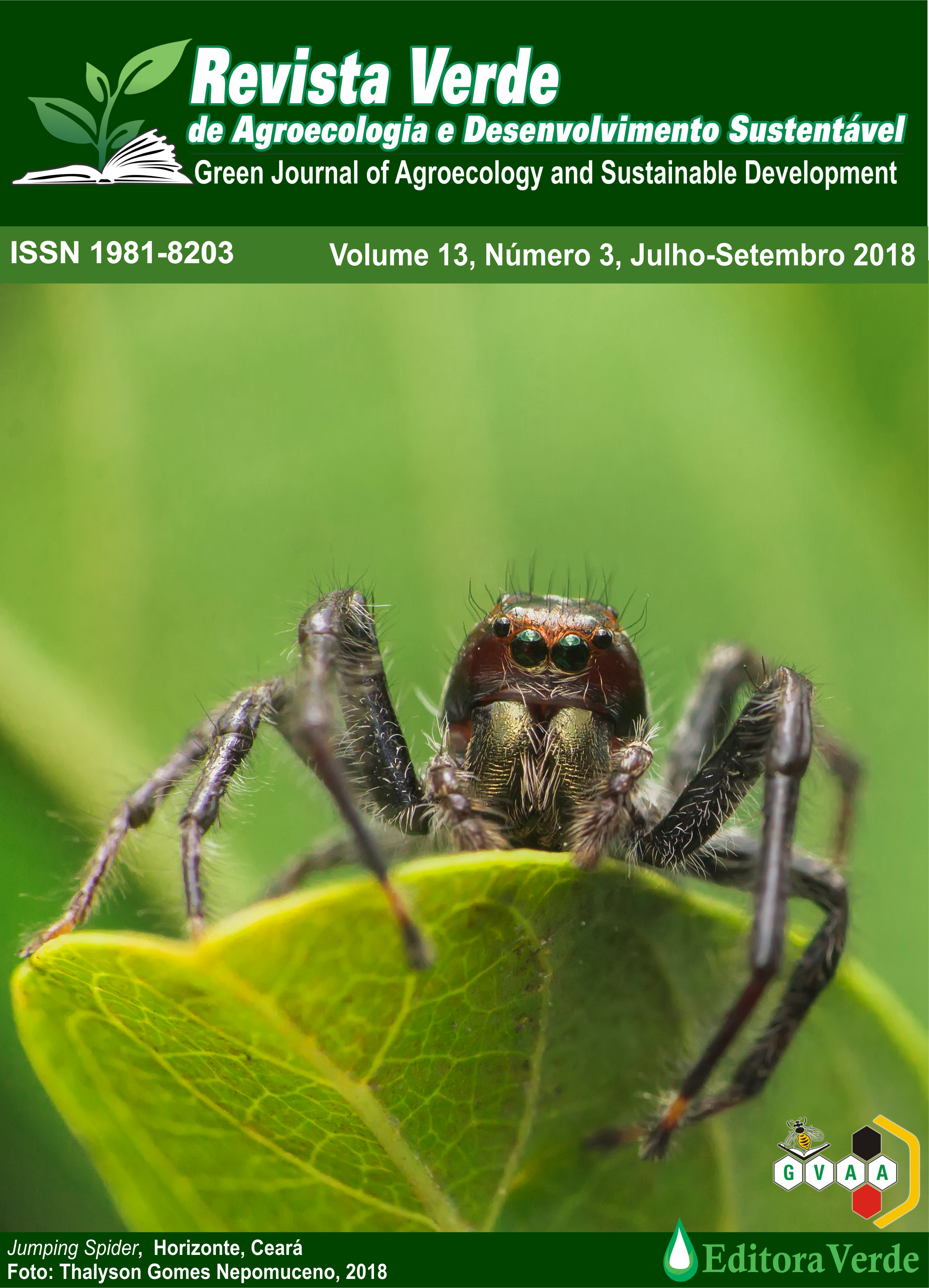Identification of families F2:3 of homozygous tomatoes resistant to Ralstonia pseudosolanacearum e Ralstonia solanacearum
DOI:
https://doi.org/10.18378/rvads.v13i3.5442Keywords:
Bacterial wilt, Selection, Solanum lycopersicum L.Abstract
The objective of this work was to identify homozygous F2:3 tomato families resistant to Ralstonia pseudosolanacearum and Ralstonia solanacearum. Two experiments were carried out under greenhouse conditions at the Federal Rural University of Pernambuco, one for each pathogen. We evaluated 45 treatments composed of Yoshimatsu (resistant) and IPA-7 (susceptible) and 43 families F2:3 obtained from generation F2. Each treatment consisted of 16 plants. The incidence of bacterial wilt was evaluated by means of a descriptive scale of notes at 20 days after inoculation. The families were compared with the parents according to the frequency of plants obtained for each note. The chi-square test (χ_c^2) was obtained, obtaining the significance of each of the parents. For the species R. pseudosolanacearum three homozygous resistant families were identified: Family F2:3 # 04, Family F2:3 # 29 and Family F2:3 # 31. Regarding R. solanacearum species, two homozygous resistant families were identified: Family F2:3 # 41 and Family F2:3 # 42. These families indicate the possibility of new resistant strains that can be used in breeding programs.Downloads
References
CAMPOS, G. A.; SILVEIRA, M. A.; AZEVEDO, S. M.; MALUF, W. R.; RESENDE, J. T. V. Resistência de linhagens de tomateiro à murcha bacteriana no Estado do
Tocantins. Horticultura Brasileira, Brasília, v. 16, n. 1, p. 46, 1998.
DENNY, T. P. Plant pathogenic Ralstonia species. In. GNANAMANICKAM, S. S. (Ed.). Dordrecht: Springer Publishing, 2006. p.573-644.
FAOSTAT. Database Results. 2015. Disponível em: http://apps.fao.org. Acesso em: 29 Mar. 2017.
FELIX, K. C. S., SOUZA, E. B., MICHEREFF, S. J.; E MARIANO R. L. R. Survival of 458 R. solanacearum in infected tissues of Capsicum annuum and in soils of the 459 state of Pernambuco, Brazil. Phytoparasitica, Bet Dagan, v.40, n.1, p.53-62, 2012.
FIORINI, C. V. A.; GOMES, L. A. A.; LIBÂNIO, R. A.; MALUF, W. R.; CAMPOS, V. P.; LICURSI, V.; MORETTO, P.; SOUZA, L. A.; FIORINI, I. V. A. Identificação de famílias F2:3 de alface homozigotas resistentes aos nematóides das galhas. Horticultura Brasileira, Brasília, v.25, n.4, p.509-513, 2007.
HUET, G. Breeding for resistances to R. solanacearum. Mini review article. v.5. In: ALLEN, C.; PRIOR, P.; HAYWARD, A. C. (Eds.). Bacterial wilt disease and the R. solanacearum species complex. 2 ed. Saint Paul: APS Press, 2014. p.449-461.
INSTAT. Graphpad Instat Software. Versão 3.10, 32 bit for windons. 2009.
KELMAN, A. The relationship of pathogeniciity in Pseudomonas solanacearum to colony appearance on a tetrazolium medium. Phytopathology, [S.l.], v.44, p.693-695, 1954.
KIM, S. G.; HUR, O. R. O. N.; KO, H.; RHEE, J.; SUNG, J. S.; RYU, K.; LEE, S.; BAEK, H. Evaluation 488 of resistance to Ralstonia olanacearum in tomato genetic resources at seedling 489 stage. Plant Patholology Journal, [S.l.], v.32, n.1, p.58-64, 2016.
LEBEAU, A.; DAUNAY, M. C.; FRARRY, A.; PALLOIX, A.; WAMG, J. F.; DINTINGER, J.; CHIROLEU, F.; WICKER, E.; PRIOR, P. Bacterial wilt resistance in tomato, pepper, and eggplant: genetic resourcers respond to diverse strains in the Ralstonia solanacearum species complex. Phytopathology, Saint Paul, v. 101, n. 1, p. 154-165, 2011.
LIMA NETO, A. F. L.; SILVEIRA, M. A.; SOUZA, R. M.; NOGUEIRA, S. R.; ANDRÉ, C. M. G. Inheritance of bacterial wilt resistance in tomato plants cropped in naturally infested soils of the state of Tocantins. Crop Breeding and Applied Biotechnology, Viçosa, v.2, n.1, p.25-32, 2002.
MONMA, S.; SAKATA, Y.; MATSUNAGA, H. Inheritance and selection efficiency of bacterial wilt resistance in tomato. Japan Agricultural Research Quarterly, [S.l.], v.31, n.3, p.195-204, 1997.
MOREIRA, G. R.; SILVA, D. J. H.; CARNEIRO, P. C. S.; PICANÇO, M. C.; VASCONCELOS, A. A.; PINTO, C. M. F. Herança de caracteres de resistência por antixenose de Solanum pennellii à traça-do-tomateiro em cruzamento com ‘Santa Clara’. Horticultura Brasileira, Vitoria da Conquista, v.31, n.4, p.574-581, 2013.
NICK, C.; SILVA, D. J. H. Melhoramento de tomate. In: NICK, C.; BORÉM, A. (Eds.). Melhoramento de hortaliças. Viçosa: UFV, 2016. p.396-431.
NIELSEN, L. W.; HAYNES, F. L. Resistance in Solanum tuberosum to Pseudomonas 522 solanacearum. American Potato Journal, [S.l.], v.37, p.260-267, 1960.
OLIVEIRA, W. F.; GIORDANO, L. B.; LOPES, C. A. Herança da resistência em tomateiro à murcha-bacteriana. Fitopatologia Brasileira, Brasília, v.24, n.1, p.49-53, 1998.
PRIOR, P.; BART S.; LECLERCQ S.; DARRASSE. A; ANAIS, G. Resistance to bacterial wilt in tomato as discerned by spread of Pseudomonas (Burholderia) solanacearum in the stem tissues. Plant Pathology, Oxford, v.45, n.4, p.720-726, 2016.
SANTIAGO, T. R.; LOPES, C. A.; CAETANO-ANOLLES, G.; MIZUBUTI, E. S. G. Phylotype and sequevar variability of Ralstonia solanacearum in Brazil, an ancient centre of diversity of the pathogen. Plant Pathology, [S.l.], v.66, n.3, p.383-392, 2016.
SHARMA, K. C.; SHARMA, L. K. Genetic studies of acterial wilt resistance in tomato crosses under mid-hill conditions of Himachal Pradesh. Journal of Hill Agriculture, [S.l.], v.6, n.1, p.136-137, 2015.
SOUZA, L. V.; GENTIL, D. F. O. Estaquia da cultivar de tomateiro Yoshimatsu. Horticultura Brasileira, Vitória da Conquista, v.31, n.1, p.166-170, 2013.
THAKUR, A. K; KOHLI, U. K.; KUMAR, M. Inheritance of resistance to bacterial wilt in tomato (Lycopersicon esculentum Mill.). The Indian Journal of Genetics and Plant Breeding, [S.l.], v.64, n.1, p.79-80, 2004.
ZHANG, Y.; QIU, S. Phylogenomic analysis of the genus Ralstonia based on 686 single-copy genes. Antonie van Leeuwenhoek, Switzerland, v.109, n.1, p.71-82, 2016.













